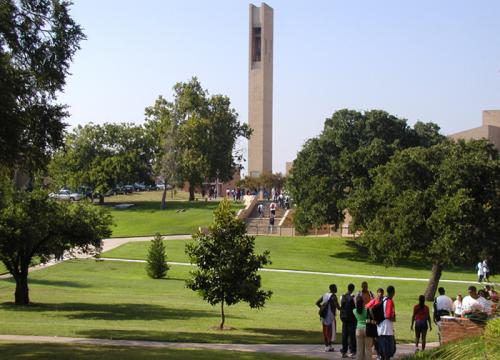In recent years, Huston-Tillotson University has been making some major waves within Austin’s green scene. Last year, the university Department of Natural Sciences and Math introduced an Environmental Studies major, the first of its kind at Huston-Tillotson. The university is also home to sustainability celebrity Jeff Wilson (Professor Dumpster), who made a name for himself last year while living in a 33 square foot dumpster on campus. Last week, Huston-Tillotson further cemented itself as a leading voice in the local environmental community by hosting the Hill Country Conservancy’s Shades of Green Learning series on campus. The series’ focus is environmental justice, a key issue both for Huston-Tillotson and for the city of Austin at large.
Beverly Wright, a professor of Sociology at Dillard University in Louisiana, was the guest speaker. Far more than an academic, Wright is also the founder of the Deep South Center for Environmental Justice (DSCEJ). Her mission, and the mission of her organization, is to empower minorities and the economically disadvantaged in the face of the many environmental crises currently facing our nation. Her geographic focus has been along the southernmost end of the Mississippi River. Known as the Mississippi River Chemical Corridor, the 85 mile stretch is home to some of the United States’ most precious wetland habitats. Local industry has also made the area the source of 85 percent of of the nation’s petrochemicals, earning it the nickname “Cancer Alley.”
“We have no idea to what extent we’re going to be affected,” says Wright. Studies have linked an industrial presence to numerous health issues that include miscarriages, cancer, respiratory ailments, and many other serious diseases. Cancer, in particular, has ravaged the local population. Seven in 10 of the top cancers in the United States are most prevalent in Louisiana. The 1985 Toxics Release Inventory (TRI) revealed that industry along the Mississippi River Corridor had dumped over 800 million pounds of carcinogens into the air, water, and soil. A follow up study conducted in the 1990s revealed the true scale of the pollution was far greater, amounting to an estimated 1.2 billion pounds. Studies by the DSCEJ showed a particularly heavy impact on minority communities. By comparing the 1990 TRI to demographic distribution, Wright and her team of researchers found that 80 percent of black Americans living within the Mississippi River Corridor lived within three miles of a petrochemical plant. As Wright puts it, “there’s nothing safe about the production of oil.”
Her solution? A program she called the “Communiversity” model. It begins with the merger of environmental activism and social justice. Wright says that for effective research and policy-making, collaboration with the knowledge of academic educators and researchers is essential. The DSCEJ offers community training to improve awareness of ecological issues and helps to gather data about those affected by environmental calamities.
The organization also provides K-12 curriculum development. For students at institutions of higher learning, the DSCEJ works closely with environmental justice student organizations at historically black colleges and universities such as Huston-Tillotson. “If it’s a conversation about black people, they need to be in the room,” Wright says. “They can’t get there if we don’t train them.”
While it certainly hasn’t happened overnight, Wright is proud to see the efforts of her organization coming to fruition. Through the DSCEJ, environmental justice clubs have teamed up with organizations such as Habitat for Humanity to offer disaster relief and education. Through collaboration with various school districts, environmental justice education and awareness programs have become increasing prevalent. In colleges, environmental justice internships are now being offered to students who might previously have had little opportunity to explore the field. And within the community, citizens and activists alike are moving to increase local involvement in decision-making and politics. As of the fall of 2015, the DSCEJ’s ranks have swollen to an alliance of 22 groups working to promote environmental justice and an equitable green movement.
“We’re now on our way to Paris,” Wright said to the crowd at Huston-Tillotson, referring to the upcoming 2015 United Nations Climate Conference. “We’re trying to train the next generation of people to continue the fight against our extinction and the destruction of our planet.”



